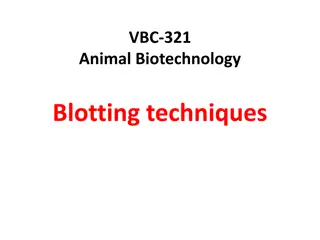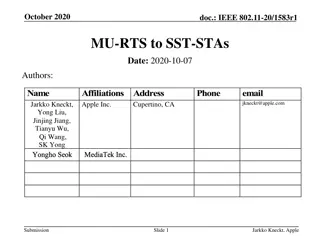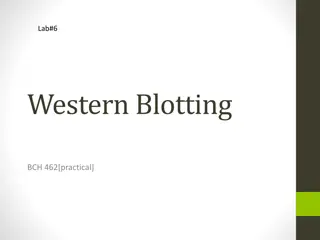
Understanding Blotting Techniques and Their Applications
Explore the definition, history, and process of blotting techniques such as Southern, Northern, and Western blotting for DNA, RNA, and protein analysis. Learn about the steps involved in blotting and how it aids in hybridization experiments.
Download Presentation

Please find below an Image/Link to download the presentation.
The content on the website is provided AS IS for your information and personal use only. It may not be sold, licensed, or shared on other websites without obtaining consent from the author. If you encounter any issues during the download, it is possible that the publisher has removed the file from their server.
You are allowed to download the files provided on this website for personal or commercial use, subject to the condition that they are used lawfully. All files are the property of their respective owners.
The content on the website is provided AS IS for your information and personal use only. It may not be sold, licensed, or shared on other websites without obtaining consent from the author.
E N D
Presentation Transcript
CONTENT : Defination of blotting History Southern blotting Northern blotting Western blotting Application
DEFINATION : Transfer of DNA or RNA or protiens fractinated by gel electrophoresis to a nitrocellulase paper or nylon mesh for separation , identification and analysis is called blotting or blot transfer . It is carried out by allowing a liquid to seep through electrophoresed gel , nitrocellulose paper and a pile of filter papers. They are very important for hybridisation experiments to determine the DNA , mRNA or protiens in electrophoresed gels ,
HISTORY In general , nylon membrane or nitrocellulose membrane is used for blotting tests . This technique was first devised by ED. SOUTHERN in 1975.
SOUTHERN BLOTTING : It is the separation of DNA fragments from a sample by blotting on a membrane . It was devised by Southern in 1975 . STEPS INVOLVED : The DNA is cut with restriction enzyme to produce dna fragments of different sizes. It is subjected to gel electrophoresis which results in separation of dna fragments based on their size . It is denatured by alkali to produce single stranded dna .
The dna strands are transferred from agarose gel to a nitrocellulose filter with the help of following steps : BLOTTING: A filter paper bridge on supporting bench is placed in a plastic tray . The buffer is poured on to the tray for about 2/3 of the height of the filter bridge . The gel containing denatured dna is placed on filter paper bridge . A nitrocellulose filter membrane is placed over the agarose gel .
dry filter paper are placed on the nitrocellulose membrane . At top a glass plate is placed and a paper wieght is placed on a glass plate. The set up is kept for 4 to 8 hours . Buffer moves from tray through agarose gel to nitro cellulose filter. The buffer carries with it the dna from the gel . The dna is trapped in the membrane . The position of bands remains same as in the gel .
The dna strands are firmly fixed to nitrocellulose membrane filter by baking at 80 degree celcius . The blotting filter is kept between dry filter papers and kept in oven at 80 degree. This is called baking. Then filter paper is placed in solution containing radio-labelled rna or single stranded dna probe of known sequence . The radiolabelled one will form base pairs with complementary dna fragments in the filter.
The hybridization regions are recorded on x- ray film by autoradiography. The x-ray film by its bands will show the relative position of the gel containing dna complementary to the probe . Thus the sequences of dna are recorded by the following sequences of nucleic acid probe.
The hybridization regions are recorded on x- ray film by autoradiography. The x-ray film by its bands will show the relative position of the gel containing dna complementary to the probe . Thus the sequences of dna are recorded by the following sequences of nucleic acid probe.
NORTHERN BLOTTING: It is a method of separation of mRNAs from a sample by blotting on a membrane . It was devised by ALWINE and his colleagues in 1979 In this technique mRNAs are transferred from gel to a filter paper STEPS : The mRNAs are separated by GE. The electrophoresed gel is immersed in depurination buffer for 10 minutes and then washed with water .
Then the mRNAs present in the gel are transferred to ABOM filter paper . A filterv paper bridge on supporting bench is placed on a plastic tray The buffer is poured into the tray The gel containing single stranded RNAs are placed on filter paper bridge. The ABOM Membrane is placed over the gel . Dry filter papers are placed on the ABOM membrane .
At top a glass plate is placed and then a paper weight is placed on the glass plate The setup is kept for 4 to 8 hours . The buffer moves from gel to ABOM filter. The buffer carries with it the RNAs from the gel. The RNAs are trapped in the ABOM filter . The position of the bands on the membrane remain same as in the gel . The mRNA blotted filter paper is kept between the dry filter papers and baked at 80degree.
The blotted filter is treated with pre- hybridisation solution and then placed in a heat resistant bag . A particular DNA probe and hybridization solution are filled in the bag and the bag is sealed . The bag is kept at 42 degree for 4 to 8 hours to carry out hybridization The filter is then washed with wash solution to remove the unbound probes An autoradiogram is taken to know the exact position of filter having hybrid mRNA-DNA.
WESTERN BLOTTING: The transfer of proteins from electrophoresed gel to nitro cellulose filter . Itv was devised by TOWBIN in 1979. It is an immuno detection method working according to the principle of antigen antibody reaction . STEPS-: protien are extracted from a cell . Protein isolate is electophoresed in polyacrylamide gel to separate various protein based on their size SDS IS added to the sample before electrophoresis to solubelize protein for easy separation.
The protein are transfer from the polyacrylamide cell by western blotting. STEPS-: The gel is immersed in transfer buffer are 40 degree (TGM buffer )43 minutes. Nitro cellulose filter,Whatmann filter and coarse filter are soaked well with TGM buffer. A stack of coarse filter is kept in between two Whatmann filters . It is placed on cathode plates of western blot apparatus.The gel is placed on filters stack.
A nitrocellulose filter is placed on the gel . Another stack of filter paper is placed on the nitrocellulose filter. A whatmann filter is placed on it . The anode plate is kept on the whatmann filter . A 500mA current is supplied to the apparatus for one hour. During this time the proteins are transferred from the gel to the nitrocellulose filter. The filter is taken and kept in blocking solution at 37degree for 30minutes.
The blocking solution contains bovine serum albumin (BSA) or milk powder . The proteins binds with unoccupird sites on the filter for blocking the binding of antibodies with the filter. Antibody against the target protein to be detected is prepared from rabbit and labelled with radioactive I125. After blocking the nitrocellulose filter is placed in the solution containing radiolabelled antibodies for 12hours .
The nitrocellulose filter is washed with a wash solution ( tris-buffered saline + tween 20 ) to remove unbound antibodies. The filter is exposed to an x-ray film for 4hours to take an autoradiogram . Dots in the radiogram indicate the presence of target protein in the protein isolate.
APPLICATION: SOUTHERN BLOTTING : Help to isolate a desired DNA for the construction of rDNA. It is used for dna fingerprinting . NORTHERN BLOTTING : It is used in the separation and identification of particular mRNA in a sample . Used in the diagnosis of infectious diseases byb detecting the mrna of the concerned pathogen in the tissue specimens
WESTERN BLOTING : Used in clinical diagnosis of complicated diseases . Very sensitive analytical method which can detect target protien even if it is present as low as 5mg in one litre of crude sample.






















